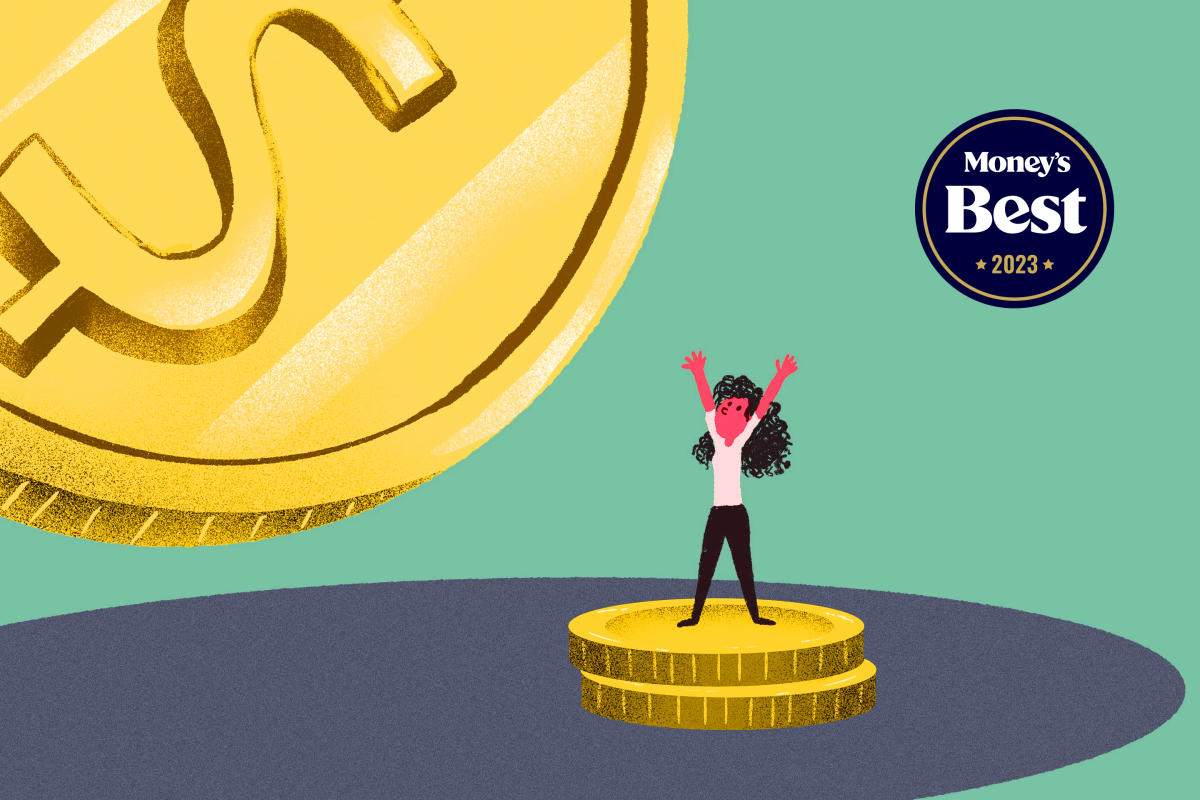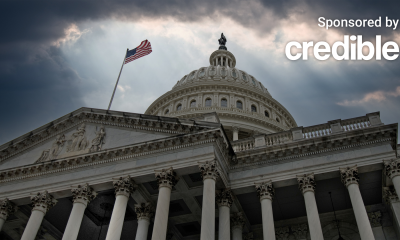Personal Finance
Best Personal Loans of March 2023

Our Partners
Top Partner
Our Partner
Get Started
-
Get personalized pre-qualified offers from multiple lenders.
-
2 Minute Process
-
$600 – $100,000 loans.
-
Rates from 5.40% – 35.99% APR
-
Loan terms of 2 to 7 years.
-
Rated A+ by the BBB
Our Partner
Get Started
-
Personal Loans up to $50,000
-
Rates from 2.49% – 35.99% APR
-
Funds as fast as 24 hours
-
Loan terms of 3 mo – 15 years
-
Easy to compare then apply
-
Credit Score: Excellent/Good/Fair/Poor
Sample loan: a four-year $20,000 loan with an interest rate of 2.49% and an APR of 2.49% will require an estimated monthly payment of $561.60 and a total cost of $26,956.57.
Our Partner
Get Started
-
Loan Amount: $1,000 – $100,000
-
APR: 2.49% – 35.99%
-
Loan Term: 3 – 120 months
-
Explore all your options at once and find the best offers for you.
-
You can get your funds in as little as 1 day from approval.
-
Loan consultants available to help you understand your options.
Sample loan: a four-year $15,000 loan with an interest rate of 15.49% and an APR of 18.34% will require an estimated monthly payment of $421.20 and a total cost of $20,217.43.
Whether you’re looking to consolidate debt, finance a big purchase or make home renovations, a personal loan could be the right tool to help you get there.
Get started with our list of the best personal loan companies of 2023. Reviews include credit score requirements, available loan terms, loan amounts and annual percentage rates.
Our Top Picks for the Best Personal Loan Companies of March 2023
-
LightStream – Best Variety of Loan Options
-
Credible – Best Marketplace
-
SoFi – Best Online Lender
-
Upstart – Best Peer-to-Peer Lender
-
PenFed – Best Credit Union
-
U.S. Bank – Best Bank
Best Personal Loan Reviews
Pros
-
Online application
-
No origination fees
-
No prepayment penalties
Cons
-
Requires good or excellent credit scores
-
No pre-approvals
-
High minimum loan amount
HIGHLIGHTS
- Term Lengths
- Loan amounts
- APR
- Minimum credit score required
- Autopay discount
Why we chose it: LightStream offers a wide variety of loan options and terms ranging from two to eight years, which is longer than most competitors. Additionally, LightStream offers a low starting APR (5.99%), with a discount option for AutoPay.
LightStream, a division of Truist Financial Corporation, has a wide range of loan options, a low minimum APR and loan terms that can range from two to eight years, some of the longest repayment terms available in the market. You can take out a personal loan for any service, product or purchase such as home improvement projects, medical bills, vacations, big purchases, K-12 education, recreational vehicles or family planning.
LightStream offers some of the lowest rates in the industry with a starting APR rate of 5.99%. Borrowers benefit from an additional 0.50% discount on their APR if they sign up for AutoPay. Additionally, Lightstream’s Rate Beat program offers a 0.10% discount if a borrower is offered a lower APR by a competing lender (if approved for the same loan options offered by LightStream).
As part of its customer satisfaction guarantee, LightStream will pay you $100 if you’re not satisfied with your experience after closing the loan.
We also like LightStream’s sustainability measures — not only is the online loan process largely paperless, the company partners with American Forests to plant a tree for every loan closed.
Pros
-
Free lending marketplace
-
Compare quotes from 17 lenders
Cons
-
Not a loan servicer
-
Approval requirements vary per lender
HIGHLIGHTS
- Term Lengths
- Loan Amounts
- APR
- Minimum Credit Score Required
- Autopay discount
Why we chose it: Credible lets borrowers compare multiple quotes from some of the top-rated personal loan lenders in the market.
Credible’s lending platform lets you compare quotes from 17 lenders in as little as two minutes — without making a dent in your credit score. The company features an excellent network of reputable lenders, which include SoFi, LightStream, PenFed and others.
This can save you time and money by narrowing your choices by location, loan amount, desired APR and loan purpose.
Additionally, Credible offers a $200 Best Rate Guarantee incentive. If you find a personal loan with a lower rate on a competing website and submit it to them within 10 days of receiving Credible’s personal loan rates, the company will give you $200.
The company welcomes applicants with a variety of credit histories, but applicants with excellent credit histories tend to see more loan offers, more flexible repayment terms and lower interest rates. Credible also offers tools to check how prequalifying rates are affected by adding different co-signers.
Pros
-
Compare quotes from 12 lenders
-
Transparent lender profiles
-
Free credit and debit analysis tool
Cons
-
A higher number of CFPB complaints
-
Prepayment penalties may apply
-
Origination fees may apply
HIGHLIGHTS
- Term Lengths
- Loan Amounts
- APR
- Minimum credit score required
- Autopay discount
Why we chose it: We chose LendingTree as a runner-up for our best loan marketplace because it partners with some of the top lenders in the industry. However, compared to competing marketplace Credible, it had a higher number of CFPB complaints.
Like Credible, Lending Tree is a marketplace where you can shop for personal loans from reputable lenders. You can receive quotes within minutes.
LendingTree’s website is easy to use and clearly lists their lenders’ current APR rates as well as the minimum credit score needed to apply — for example, as of January 2023, the minimum credit score required is 300 (Upstart personal loans). Additionally, it offers individual lender descriptions and a personal loan payment calculator to help you make your best choice.
Pros
-
No origination or late fees
-
No prepayment penalties
-
Unemployment protection for up to a year
Cons
-
High minimum loan amount
-
Requires good to excellent credit
HIGHLIGHTS
- Term Lengths
- Loan Amounts
- APR
- Minimum Credit Score Required
- Autopay discount
Why we chose it: Online lender SoFi stands out for its ease of use, fast application process and additional services such as unemployment protection and one-on-one financial planning.
Initially a student loan lender, SoFi now offers personal loans of up to $100,000, one of the highest loan amounts on this list. You need a good credit score with a minimum of 680 to apply, but there’s a lot to like about SoFi personal loans.
SoFi considers alternative credit data — free cash flow, professional history and history of financial responsibility — while still offering competitive interest rates. If you don’t meet SoFi’s requirements, you can apply with a co-borrower (note that adding a co-borrower will extend the loan review process by 1-2 weeks). Additionally, you can pause loan payments for a certain period of time during important life changes such as graduation or starting a new job.
SoFi also offers unemployment protection for up to a year. If you lose your job, you can request to modify your monthly payments. In addition, SoFi provides free education tools like career coaching and financial advice.
The application process is entirely online and can be completed in a matter of minutes. While most applicants will have to wait a few business days to receive their funds, some can have their loan amounts deposited the same day the loan is approved.
Pros
-
Accepts applicants with short credit histories
-
Considers alternative credit data
-
No prepayment penalties
Cons
-
Offers only two repayment terms
-
Charges origination fee
-
Additional fee for a paper copy
HIGHLIGHTS
- Term Lengths
- Loan Amounts
- APR
- Minimum Credit Score Required
- Autopay discount
Why we chose it: Upstart is the only peer-to-peer lender that accepts applicants with lower FICO scores and short credit histories.
Upstart’s peer-to-peer model is simple: instead of getting the money from a traditional financial institution, you get it from investors. Upstart’s AI-powered loan application model takes into account your job history, the highest level of education you’ve received and your area of study to determine eligibility.
Upstart is the only peer-to-peer lender that accepts applicants with a fair credit score (580-669) and short credit histories. Even unemployed individuals may apply as long as they have an employment offer with a starting date that isn’t more than six months from the date of application.
You can check your rate before applying, and loan funds can be disbursed as early as the next business day after you close on the loan.
Pros
-
Physical branches nationwide
-
No prepayment penalties
-
No origination fees
Cons
-
Membership fee
-
No cosigners allowed
HIGHLIGHTS
- Term Lengths
- Loan Amounts
- APR
- Minimum Credit Score Required
- Autopay discount
Why we chose it: PenFed offers both the nationwide presence of a traditional brick-and-mortar lender and credit union perks. Borrowers benefit from lower interest rates and a broad range of repayment term options.
PenFed is our top credit union for personal loans because of its repayment term options, low loan amounts and lack of loan origination fees or prepayment penalties.
The company offers a lower APR range than other credit unions, and candidates can apply individually or with a co-borrower. Non-members can apply for a personal loan and only need to join if they choose to accept the loan offer.
Membership was previously limited to the military, certain government agencies, and residents of eligible locations, but as of 2019, PenFed makes it easy for others to join. All you have to do is select “None of the above” in the membership application’s eligibility section and make a $5 deposit to your savings account.
Pros
-
No origination fees or prepayment penalty
-
Fast funding
-
Online loan application
Cons
-
Minimum 660 credit score for non-U.S. Bank customer
-
Loan limit is $25,000 for non-U.S Bank customer
HIGHLIGHTS
- Term Lengths
- Loan Amounts
- APR
- Minimum Credit Score Required
- Autopay discount
Why we chose it: U.S. Bank offers lower APRs than most traditional banks and quick funding — within hours, according to the lender — if you’re an existing customer with a credit score of 660 or higher.
U.S. Bank has a starting APR that competes with the best personal loan rates in the industry. Its maximum personal loan APR caps out at 21.49%, much lower than those of other big banks like Citi and Wells Fargo, which cap their APRs at around 24%.
U.S. Bank also has an emergency Simple Loan available for minor, short-term expenses with a minimum loan amount that starts at $100 and goes up to $1,000. While the Simple Loan has a $6 monthly fee for every $100 you borrow, it could be a good alternative if you need a smaller amount quickly.
Do note, however, that, if you do not have a bank account with U.S. Bank, you will be subject to stricter credit score requirements and may only borrow up to $25,000.
Other personal loan companies we considered
Marcus by Goldman Sachs Personal Loans
Pros
-
No late fees or prepayment penalties
-
One-time deferral bonus after consecutive, on-time payments
Cons
-
No co-signers or co-borrowers
-
No short-term loan options
Marcus by Goldman Sachs specializes in debt consolidation loans and has many worthy features including no service fees and customizable due dates. Customers can change the loan payment date up to three times during the term.
Marcus by Goldman Sachs also earned the top spot in J.D. Power’s 2022 U.S. Consumer Lending Satisfaction Study. However, it doesn’t allow co-signers or co-borrowers, which can be a deal-breaker for borrowers with lower credit scores.
Why Marcus by Goldman Sachs didn’t make the cut: Marcus by Goldman Sachs was not included in our top list due to its lack of short loan terms — between 12-24 months — and because it does not allow co-signers or co-borrowers.
Best Egg Personal Loans
Pros
-
Fast online loan approval
-
Next-day funding
Cons
-
High origination fees
-
Not available in six states
Best Egg specializes in debt consolidation loans and features quick one-day funding and online approval. However, customers may only have a maximum balance of $50,000 across multiple loans and origination fees are fairly high compared to competitors. Unfortunately, its products are not available in the District of Columbia, Iowa, Vermont, West Virginia or U.S. territories.
Why Best Egg didn’t make the cut: Best Egg didn’t make our list because its personal loans are not available across all of the U.S., namely the District of Columbia, Iowa, Vermont, West Virginia or U.S. territories.
Prosper Personal Loans
Pros
-
Accepts lower than average credit scores
-
No prepayment fees
-
Pre-approval available
Cons
-
Charges origination fee
-
A high number of CFPB complaints
Prosper is a peer-to-peer lending marketplace offering loans funded by investors. It offers borrowers $2,000 to $5,000 loans, however, these loans are not available for residents of Iowa, West Virginia or U.S. territories.
Why Prosper didn’t make the cut: The high number of complaints lodged against the company with the Consumer Financial Protection Bureau (CFPB) knocked Prosper off our main list.
LendingClub Personal Loans
Pros
-
Pre-approval available
-
No prepayment penalties
-
Accepts cosigners
Cons
-
Loan amounts up to $40,000
-
3% – 6% origination fee
LendingClub is yet another peer-to-peer lending marketplace to compare personal loans. Its loans have no prepayment penalties and you are allowed to have cosigners, but the maximum low limit is relatively low at $40,000 and origination fees are fairly high at 3% – 6%.
Why LendingClub didn’t make the cut: We didn’t include LendingClub on our list because of its high origination fees and comparatively low maximum loan amount ($40,000).
USAA Personal Loans
Pros
-
Variety of personal loan options
-
Low number of CFPB complaints
Cons
-
Limited membership
-
No pre-approval
USAA features a variety of loan options ranging from $2,500 to $100,000, with repayment terms ranging from 12 to 84 months. Applications for loan terms longer than 60 months must meet higher credit and risk standards than loan terms up to 60 months. Additionally, loan APR ranges from 7.14% to 18.5% (with Auto Pay) which is higher than many competitors and its services are only available for military members and their families.
Why USAA didn’t make the cut: USAA was not included in our top list because their loan offerings are limited to military members and their families, as well as the higher than average APR on their loans.
Wells Fargo Personal Loans
Pros
-
Accepts fair credit scores
-
No prepayment penalty
-
Over 8,000 physical branches
Cons
-
A high number of CFPB complaints
-
Doesn’t accept cosigners
Wells Fargo is one of the largest and oldest banks in America. Its personal loans — available to customers with a ‘fair’ or higher credit score — range from $3,000 to $100,000. Borrowers can pick a repayment term between 12 to 84 months. The presence of over 8,000 physical branches also makes it a good choice for anyone who prefers in-person service.
Why Wells Fargo didn’t make the cut: The high number of complaints filed against Wells Fargo with the CFPB disqualified it from our list.
Avant Personal Loans
Pros
-
Lenient underwriting
-
Accepts fair credit scores
Cons
-
High loan origination fees
-
Administration fees
-
Federal Trade Commission (FTC) civil lawsuit
Avant uses a proprietary algorithm to determine borrowers’ creditworthiness, making its underwriting more lenient. However, it charges high origination and administrative fees and has less competitive rates. Moreover, in January 2022, the Federal Trade Commission returned $3.7 million to Avant customers after alleging the company had engaged in deceptive loan practices.
WhyAvant didn’t make the cut: Avant didn’t make the top list due to its high loan origination fees, its administration fees and a recent FTC lawsuit that forced the company to return millions of dollars to its customers.
Discover Personal Loans
Pros
-
No prepayment penalty
-
Next-day fund disbursement
Cons
-
$39 late payment fee
-
$25,000 minimum annual income required
-
No cosigner option
Credit card issuer Discover also originates loans — from $2,500 up to $35,000 — with 0% in origination fees and which you can repay over a period of 3 to 7 years. Interest rates are somewhat higher than average, ranging from 6.99% to 24.99% APR.
Why Discover didn’t make the cut: Discover didn’t make our top list due to its minimum income requirement and the fact that it doesn’t allow co-signers on loans.
Personal Loans Guide
Personal loans can be used for a variety of purposes. Many of these loans offer great benefits such as flexible terms and low interest rates. Our guide outlines everything you need to know, including how they work and what qualifications you need to get a personal loan.
Table of contents
-
What is a personal loan
-
How do personal loans work
-
What are personal loans used for?
-
Personal loans pros and cons
-
Types of personal loans
-
Where to get a personal loan
-
How to get a personal loan
-
How to compare personal loan lenders
What is a personal loan?
Personal loans are a type of installment loan.
Compared to other types of loans, personal loans may feature shorter repayment terms — typically between 12 and 72 months — and fixed interest rates.
These loans can be used for debt consolidation, home improvement projects, medical expenses or for financing big purchases, events or vacations.
How do personal loans work?
You can request personal loans from banks, credit unions or other financial institutions.
Lenders will look at different factors when evaluating your application. These include:
-
Debt-to-Income Ratio (DTI). This is your monthly debt — such as mortgage payments, credit card debt, alimony or student loans — divided by your gross monthly income. This shows banks how much of your income is being used to pay existing debt and whether you can afford to pay this new loan. Overall, the lower your DTI, the likelier you are to get approval.
-
Credit score. Lenders will pull your credit report and review your credit score. Lenders prefer a FICO credit score of 660 or more. It’s a good idea to do this yourself before applying for a loan. If you need help doing that, make sure to read our article on how to check your credit score.
-
Credit utilization ratio. Banks will review how much of your available credit you’re currently using. Most lenders favor a credit utilization ratio below 30%.
Most personal loans have fixed interest rates and are processed quickly – once approved, you could have money deposited into your bank account within 24 to 48 hours.
What are personal loans used for?
Many people use personal loans to pay for large, unplanned expenses, such as medical expenses or car repairs. Others take out loans to pay for a vacation, a wedding or home improvement projects. Personal loans can also come in handy when you want to consolidate or refinance existing debt.
-
Emergency expenses. Unforeseen medical, car repair or funeral expenses can often throw you and your finances into disarray. A personal loan helps you cover these expenses when they come up and gives you time to pay off the expense over the term of the loan.
-
Home improvement. You can take out a personal loan to cover expenses related to the repair or remodeling of your home. Making improvements to your home also helps you boost your home equity.
-
Debt consolidation. A common use of personal loans is for consolidating and refinancing existing debt. Many do this to lower monthly payments or take advantage of lower interest rates, especially if they have high-interest credit card debt.
-
Moving costs. Moving costs can quickly add up when you factor in not only having to move your belongings, but also possibly buying new appliances or furniture. A personal loan helps you cover these costs so you can focus on settling into your new home.
-
Major purchases or events. Personal loans are also a way of paying for big purchases you plan to make. An example of these are for weddings, vacations, a new energy-saving appliance or even a new laptop.
-
Auto financing. Some people opt for a personal loan to buy a car because these are less restrictive than car loans and they don’t require using the vehicle as collateral. Others use personal loans when buying cars from other people and not directly from a company or used car dealer.
While you can buy a car with a personal loan, we don’t recommend it because it’s more expensive. Because they don’t require collateral, interest rates on unsecured personal loans are higher and typically incur more fees than auto loans do.
Personal loans pros and cons
Although personal loans can be an easy way of getting money in your pocket quickly, there are drawbacks. Knowing the cons as well as the pros will help you determine if a personal loan is the best financial product for your situation.
Pros
-
<strong>Low interest and fixed rates.</strong> For borrowers with good to excellent credit, personal loans offer lower interest rates than credit cards.
-
<strong>Doesn’t require collateral.</strong> Personal loans are typically unsecured, so they don’t require you to guarantee the loan with an asset (such as your home or vehicle).
-
<strong>Flexibility of amount.</strong> The loan amount you’re approved for will depend on your credit score. With good credit, you could get a loan of up to $100,000 for anything from purchasing a new laptop to renovating your home.
-
<strong>Get money fast.</strong> Once approved, most lenders send you the money quickly. Some do so in as little as 24 hours.
Cons
-
<strong>Higher APRs.</strong> Personal loan APRs tend to be higher for those with low credit scores. Sometimes interest rates can be as high or higher than for credit cards.
-
<strong>Higher monthly payments.</strong> Personal loan payments are often higher than the minimum monthly payment on credit cards.
-
<strong>Hard to qualify if you have a low credit score.</strong> Most financial institutions require at least a 620 FICO score in order to approve a loan.
If your credit score is too low to secure a personal loan, you may want to check out our list of the best loans for bad credit if you want to explore different options.
Types of personal loans
There are two basic types of personal loan: secured and unsecured loans.
Secured loans
Secured loans require collateral, which is a guarantee of payment in the form of an asset you own such as your house, car, stocks and bonds or even a certificate of deposit account. If you default on these loans, the lender can sell these assets and use them to pay off the debt.
Unsecured loans
Unsecured loans don’t require collateral, and therefore, won’t lead to foreclosure or loss of assets. However, these loans usually carry higher interest rates, and defaulting will still significantly impact your credit score. Most personal loans are unsecured loans.
Where to get a personal loan
You can get personal loans from banks, credit unions, or from online and peer-to-peer lenders such as the ones featured on our list.
It’s important you only apply to reputable lenders since you’ll have to provide your personally identifiable information on your application, including your social security number and address.
Banks
Brick-and-mortar banks are ideal if you prefer in-person customer service. At your local bank you can get solutions tailored to your situation as well as advice on your finances. As banking becomes ever more digital, most brick-and-mortar banks are now able to offer you the best of both worlds. The drawback of old-school banks is that they may charge higher fees and penalties than online lenders and credit unions.
Online Lenders
Online lenders offer convenience and speed. You can apply and receive your money online from anywhere (we suggest you use a secure WiFi connection). Another perk of online lenders is that some pass on their overhead cost savings to you and offer better APR rates and lower fees. Additionally, some online lenders use alternative credit data, making them an excellent option for borrowers with shorter or non-traditional credit histories.
Credit Unions
Unlike traditional banks, credit unions are nonprofit financial institutions. Any potential borrowers must first become a member, but this can offer some benefits — being a member not only gives you access to their products, but also to profits and savings. This means access to higher interest rates on savings accounts and CDs and lower APRs on loans. Their accounts are insured by the National Credit Union Administration (NCUA) and this same administration caps the loan interest rates offered by credit unions at 18%.
Peer-to-Peer
Another way of getting a loan is from a peer-to-peer (P2P) lender, a type of online lender that connects borrowers to funding from individual investors and companies. In peer-to-peer lending, because you get the money from another individual or institution, the lending companies only facilitate the loan. This type of loan gives people with low credit scores or limited credit history greater chance of approval.
Do note that P2P lenders often charge additional fees and higher personal loan interest rates.
How to get a personal loan
Regardless of whether you want to get your loan from a traditional bank, a credit union, an online lender or P2P, there are steps you’ll have to follow to get your loan.
-
Do the math. Take a hard look at your finances and determine if you can afford the new loan payment. Some banks offer fast, online prequalification, which could let you know how much you’d likely be approved for and, in most cases, does not impact your credit. You can also use an online personal loan calculator to get an idea of what you’ll have to pay every month for the loan.
-
Check your credit scores. Personal loan lenders run a credit check to determine your creditworthiness and interest rate. Lenders usually require a minimum credit score of 620, but most prefer 660 and above. Having a credit score that’s considered good or better will get you the lowest APRs.
-
Choose a type of loan. Before applying, you must choose between a secured or unsecured loan. Remember that secure loans require collateral, so you’ll have to decide whether you want to put assets down as collateral in exchange for more favorable interest rates.
-
Evaluate and compare lenders. Before you apply for a loan, evaluate the lenders you’re interested in using. Compare each of the lenders’ loans, fees, services and benefits to find out which best fits your needs and wants. Don’t forget to look at customer reviews as well to get a sense of what other borrowers have found helpful or inconvenient.
-
Apply and provide documents. Gather the documents you’ll have to provide the lender and contact the lender to apply. These documents are usually an identification (driver’s license, passport or social security card), a utility bill to verify your address and a bank statement or tax return as proof of income.
-
Accept the terms. Read the terms and conditions carefully before accepting. Depending on the lender, receiving your funds could take anywhere between one business day to a week.
-
Start making payments. As soon as you’re approved and receive your money, start keeping track of your account and find out when your payments are due. We recommend you set up automatic payments to avoid paying the penalty or fees that most lenders charge for missed payments.
How to compare personal loan lenders
When choosing a lender, it’s important to understand the terms and the true costs of the loans they offer. It’s also important to get acquainted with the many factors they evaluate when processing your application. For example, in addition to your credit score, banks will also take a look at your employment history, credit utilization and your debt-to-income ratios, among other things.
Read on for some additional tips to help you make the right choice.
Check the lender’s prequalification and preapproval requirements
When you’re getting ready to apply for a personal loan, you’ll often hear the terms prequalification and preapproval. Both these terms involve an assessment of your current financial situation. Sometimes these terms are used interchangeably; however, often there are important differences to be aware of.
-
Prequalification involves a “soft” inquiry of your credit history, meaning it won’t leave a mark on your credit report. A prequalification lets you know whether you’d be approved for a loan and can give you a rough estimate as to the amount you could borrow. It does not, however, mean you’re approved for the loan.
-
Preapproval involves a “hard” credit inquiry, which can slightly impact your score. Because it’s a more thorough evaluation of your finances, preapproval can give you a better idea of the final amount and APR you will qualify for.
Compare interest rates vs annual percentage rate
It’s important to know the difference between interest rates and APR when comparing loan options.
-
Interest Rate is an additional percentage, fixed or variable, that the lender will charge you to borrow the principal, or the amount you agree to borrow from a lender.
-
Annual Percentage Rate (APR) is the total annual cost you’ll pay for a loan. It takes into account the loan terms and includes the loan principal, the interest rate, plus all additional fees, such as origination fees, administrative fees and/or discounts.
Look for any additional fees
When applying for a loan, it’s important to read the fine print and look for any additional fees the bank may charge.
Here are some of the most common types:
-
Origination fees. Lenders may charge a fee for administrative processes and costs involved in your loan. These fees, also known as administrative or underwriting fees, are included in your APR rate and usually range from 1 to 8% of your loan total.
-
Prepayment fees. Some lenders may charge you a fixed fee or percentage of the total loan if you pay your loan early. The time frame for payoff and any applicable prepayment fees will be stated in your loan agreement.
-
Late payment fees. Lenders may charge a fixed amount (could be as high as $50) or a percentage of the payment due if you don’t pay on time. Some loan providers might offer a grace period. Note that if you’re more than 30 days late in your payment, the lender could report it to the credit bureaus which may affect your credit score.
Consider their customer support
Customer support is an important aspect of the services offered by lending companies. Consider the type of support you prefer and be sure to check whether the lender offers your preferred mode of communication. Most financial institutions offer the following:
-
Email
-
Chat
-
Phone
-
Physical location
-
Mobile app
Understand the terms of the loan
Personal loan repayment terms can range anywhere from a few months to eight years. Some lenders offer more flexible schedules than others and allow you to choose a monthly payment date.
Be sure to keep in mind interest rates and upfront fees as you choose a term length. While you might prefer lower monthly payments, this also means you’ll be paying the loan for a longer time and paying more in interest.
Alternatives to personal loans
Personal loans aren’t the only way to consolidate debt or pay for household repairs. You might also look into one of the following options:
-
Balance transfer credit card. With a balance transfer, you move your debt from one card to a different card with a lower APR and other introductory benefits, such as reward and points programs. Many cards will offer an introductory 0% APR specifically for balance transfers. Typically, this option is available to those with very good or excellent credit.
-
Credit card advance. A credit card cash advance is a short-term loan that you can get from your credit card issuer at almost any ATM machine. However, these cash advances are usually subject to high APRs.
-
HELOCs vs. home equity loans. Both home equity lines of credit (HELOCs) and home equity loans allow you to tap into your home’s equity and use your home as collateral. They usually have lower APRs than personal loans. Additionally, whereas HELOCs are a revolving line of credit and have variable rates, home equity loans provide you with a lump sum upfront and have fixed interest rates.
-
Cash-out refinance. In a cash-out refinance you replace your old mortgage with a larger one and receive the difference as a lump sum. The benefits are that you may be able to obtain a lower interest rate than your existing rate and receive funds in a relatively short amount of time.
-
Retirement account loans. You’re allowed to borrow up to 50% of your 401k balance (with a cap of $50,000) without getting penalized by the IRS, as long as you repay it within five years. These loans often have low interest rates. However, keep in mind you’d be repaying that loan with money that has been taxed (while the funds invested in a 401k are pre-tax dollars).
-
Emergency Assistance Loans. Many people consider applying for a personal loan when facing an emergency or when struggling to pay their bills. If this is your case, you might also want to consider these other options for financing assistance.
-
Federal rental assistance. The Emergency Rental Assistance (ERA) program provides funding at the state and local level for those who need assistance with rent and utility payments, internet and costs associated with moving, including security deposits. You can check out the Consumer Finance Protection Bureau’s website to find programs in your area.
-
HUD grants and programs. The U.S. Housing and Urban Development (HUD) Program offers the Housing Choice Voucher Program (Section 8) and housing counseling services. Additionally, HUD will provide housing inspection assistance through their Real Estate Assessment Center (REAC) to ensure the house is structurally sound and sanitary.
-
Disaster relief. If you’ve been the victim of a natural disaster, the Federal Emergency Management Agency (FEMA) could help you obtain temporary housing, funds for household repair, as well as other expenses approved by your state through the Individuals and Households Program (IHP).
Avoid these types of loans
Payday loans and title loans are also immensely popular alternatives to personal loans, especially for borrowers with fair to poor credit. There is also a lesser-known type of quick loan called the tax anticipation loan. However, we do not recommend any of these options for several reasons
-
Payday loans are typically small, quickly funded loans. Payday lenders keep a postdated check or request direct access to your checking account so they can withdraw the funds by the following payday. However, their sky-high interest rates — often as high as 400% — can make the debt balloon so quickly that borrowers find themselves unable to repay them.
-
Title loans use your car title as collateral, and lenders can repossess and resell your car or motorcycle if you don’t pay it back in time. Although these loans are relatively easy to qualify for, they have extremely high interest rates, typically from 100 to 300%.
-
Tax anticipation loans give you an advance on your tax refund and act much in the same way as a payday loan. They are issued through a third-party lender once you provide proof that you’re owed a tax refund.
Failing to pay off these loans on time has trapped many borrowers in an endless debt cycle. If you have poor credit, make sure to look into bad credit loans and secured credit cards aimed specifically at high-risk borrowers.
Latest News on Personal Loans
President Biden’s student loan forgiveness plan has been in limbo since November 2022. Back then, a federal ruling in Texas forced the government to stop accepting debt forgiveness applications until the program’s legal challenges were resolved. After three months, the Supreme Court hearings began with oral arguments from both sides. Read more in our most recent news story Student Loan Forgiveness: What to Know About Supreme Court Oral Arguments Today
Taking out a loan against your life insurance policy is tempting. After all, there’s no lengthy underwriting process, no spending restrictions and the loan is tax free. But before you consider a policy loan, it’s best to be fully informed. Our article on the Dangers of Policy Loans explains the potential risks.
Best Personal Loans FAQ
What is an unsecured personal loan?
Most personal loan lenders offer unsecured loans. Unsecured loans don’t require collateral — that is, the borrower doesn’t have to put up valuable assets as a guarantee of payment. However, this also means that unsecured loans usually have higher interest rates as they present more of a risk for lenders.
Unlike with a secured loan (a mortgage, for example), you won’t lose any assets if you were to default on an unsecured loan; however, your credit will take a hit, hindering your ability to get another loan in the future.
How many personal loans can you have at once?
Technically, there is no limit to the number of personal loans you can have at once. That said, financial institutions place limits on the number of loans they’re willing to give any one borrower at a time. These policies may vary depending on your particular circumstances. Additionally, the more debt you have, the less likely you are to be approved for a loan.
Can you use a personal loan for anything?
Some lenders restrict loans a bit more than others and forbid the use of funds for paying for college or contributing to retirement plans, among others. Additionally, taking out a loan on behalf of someone else or using it for any form of gambling — including investing — is a no-no with any type of personal loan.
Should I apply for a personal loan or a balance transfer card to consolidate my credit card debt?
Personal loans are a safer bet than a balance transfer card when it comes to credit card debt and high-interest debt consolidation. Personal loans feature fixed interest rates that tend to be lower than those offered by most credit cards, with repayment terms of up to 60 months. Lenders may even offer loans with no fees.
Balance transfer credit cards have lower interest rates than traditional credit cards, and most offer an introductory 0% APR. However, these offers typically last between 12-18 months, after which your APR will be based on your creditworthiness and market conditions. Transfer fees of up to 5% of the transferred amount may apply as well.
Can I get a personal loan while unemployed?
While it’s not impossible to get a loan while unemployed, it will be difficult without a job offer or another source of income. Some lenders may still extend you a loan offer, but keep in mind that interest rates will likely be high, as you’ll pose a higher risk of default.
How We Found the Best Personal Loans
Our methodology to find the best personal loans for our readers included an in-depth evaluation of 40 banks, credit unions, marketplaces and peer-to-peer lenders taking into account the following:
-
Loan rates and fees. We chose banks that provided the most affordable loans, that is, those that offered lowest interest rates and fees. We also evaluated which banks offered the most benefits and unique offers.
-
Loan term flexibility. We preferred banks that offered customers with multiple term options and ways to pay.
-
Customer satisfaction. We evaluated how banks ranked in J.D. Power’s Customer Satisfaction surveys and checked any complaints filed with the Better Business Bureau (BBB).
-
Regulatory compliance. We checked for complaints and reports filed with the Consumer Financial Protection Bureau (CFPB) database and the Federal Trade Commission (FTC).
Summary of Money’s Best Personal Loans of March 2023
-
LightStream – Best Variety of Loan Options
-
Credible – Best Marketplace
-
SoFi – Best Online Lender
-
Upstart – Best Peer-to-Peer Lender
-
PenFed – Best Credit Union
-
U.S. Bank – Best Bank
© Copyright 2023 Money Group, LLC. All Rights Reserved.
This article originally appeared on Money.com and may contain affiliate links for which Money receives compensation. Opinions expressed in this article are the author’s alone, not those of a third-party entity, and have not been reviewed, approved, or otherwise endorsed. Offers may be subject to change without notice. For more information, read Money’s full disclaimer.
Read the full article here

-

 Side Hustles6 days ago
Side Hustles6 days agoWhy the Best CEOs Think Like Anthropologists
-

 Side Hustles4 days ago
Side Hustles4 days agoThis User-Friendly H&R Block Software Package is Only $40, While Supplies Last
-

 Investing4 days ago
Investing4 days agoTikTok faces US ban deadline as users brace for fallout By Reuters
-

 Passive Income3 days ago
Passive Income3 days agoTrain for a New Tech Career in 2025 With This $25 Course Bundle
-

 Personal Finance5 days ago
Personal Finance5 days agoDecember inflation clouds Fed's outlook on interest rate cuts
-

 Personal Finance6 days ago
Personal Finance6 days agoCalifornia's homeowners insurance industry faces rough road ahead as wildfires continue
-

 Investing6 days ago
Investing6 days agoWhy Not Owning Bitcoin is Making You Poor
-

 Make Money6 days ago
Make Money6 days agoDon’t Settle: 5 Game-Changing Moves to Maximize Your Financial Advisor’s Impact


















